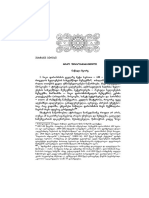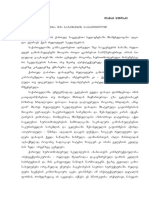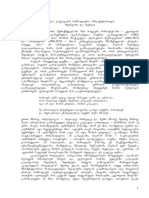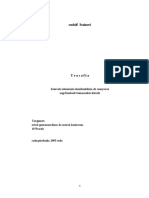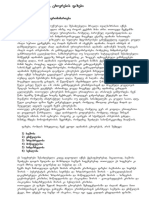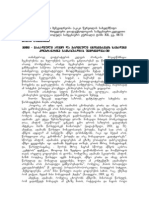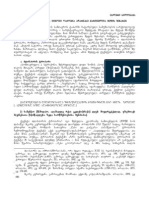0 ratings0% found this document useful (0 votes)
48 views385
385
Uploaded by
Dea GamkrelidzeThe Code of Hammurabi (c. 1750 BC) was one of the earliest and most complete written legal codes. It was enacted by the Babylonian king Hammurabi to consolidate Babylonian law and establish a standard system of justice. The code was discovered on a basalt stele in 1901-1902 in Susa, Iran and contains 282 laws.
The laws are written in the Babylonian dialect of the Akkadian language and are inscribed on the stele in columns. The code established proportionality of punishment according to the type of crime and the social class of the offender. It set out fair compensation for injuries and established a victim's right to seek legal remedy.
Copyright:
© All Rights Reserved
Available Formats
Download as DOCX, PDF, TXT or read online from Scribd
385
385
Uploaded by
Dea Gamkrelidze0 ratings0% found this document useful (0 votes)
48 views6 pagesThe Code of Hammurabi (c. 1750 BC) was one of the earliest and most complete written legal codes. It was enacted by the Babylonian king Hammurabi to consolidate Babylonian law and establish a standard system of justice. The code was discovered on a basalt stele in 1901-1902 in Susa, Iran and contains 282 laws.
The laws are written in the Babylonian dialect of the Akkadian language and are inscribed on the stele in columns. The code established proportionality of punishment according to the type of crime and the social class of the offender. It set out fair compensation for injuries and established a victim's right to seek legal remedy.
Original Title
385________ ________
Copyright
© © All Rights Reserved
Available Formats
DOCX, PDF, TXT or read online from Scribd
Share this document
Did you find this document useful?
Is this content inappropriate?
The Code of Hammurabi (c. 1750 BC) was one of the earliest and most complete written legal codes. It was enacted by the Babylonian king Hammurabi to consolidate Babylonian law and establish a standard system of justice. The code was discovered on a basalt stele in 1901-1902 in Susa, Iran and contains 282 laws.
The laws are written in the Babylonian dialect of the Akkadian language and are inscribed on the stele in columns. The code established proportionality of punishment according to the type of crime and the social class of the offender. It set out fair compensation for injuries and established a victim's right to seek legal remedy.
Copyright:
© All Rights Reserved
Available Formats
Download as DOCX, PDF, TXT or read online from Scribd
Download as docx, pdf, or txt
0 ratings0% found this document useful (0 votes)
48 views6 pages385
385
Uploaded by
Dea GamkrelidzeThe Code of Hammurabi (c. 1750 BC) was one of the earliest and most complete written legal codes. It was enacted by the Babylonian king Hammurabi to consolidate Babylonian law and establish a standard system of justice. The code was discovered on a basalt stele in 1901-1902 in Susa, Iran and contains 282 laws.
The laws are written in the Babylonian dialect of the Akkadian language and are inscribed on the stele in columns. The code established proportionality of punishment according to the type of crime and the social class of the offender. It set out fair compensation for injuries and established a victim's right to seek legal remedy.
Copyright:
© All Rights Reserved
Available Formats
Download as DOCX, PDF, TXT or read online from Scribd
Download as docx, pdf, or txt
You are on page 1of 6
ჰamurapis kanonTa krebuli (an ჰamurapiს kodeqsi) Seiqmna ჰamurapis mier
misi mmarTvelobis bolos (daaxloebiT Zveli welTaRricxvis 1750 წ.) da
warmoadgens erT-erT yvelaze uZveles sakanonmdeblo Zegls. Semoinaxa
lursmnuli damwerlobis saxiT Savi dioriTis stelaze, romeლic aRmoaCina Jak de
morganis frangulma arqeologiurma eqspediciam 1901-1902 wlebSi suzaSi
(uZvelesi mesopotamiis teritoria) gaTxrebis dros. Tanamedrove gamomcemlebi
yofen krebuls 282 muxlad.
kanonebi Sesrulebulia lursmnuli damwerlobiT boZis orive mxares akaduri enis
babilonur dialeqtze. boZიs zeda nawilSi gamosaxulia TviT ჰamurapi, romelic dgas
mlocvelis pozaSi da iRebs kanonebs taxtze mjdomi mzis RmerTis SamaSas
xelidan.
სavaraudod, stelas Seqmnis mizani iyo sazeimo gancxadeba qveSevrdomebis
winaSe masSi Semavali kanonmdeblobis ZalaSi Sesvlis Sesaxeb, da ara misi
wardgena sayovelTao gamoyenebisTvis. sasamarTlo praqtikisTvis, savaraudod,
kanonebi warmodgenili iyo Tixis fiრფიტეbis saxiT.
ჰamurapis kanonebi uSualod gamomdinareobs Sumerebis samarTlis tradiciebidan
da warmoadgens erT-erT umTavres wyaros im drois mesopotamiis samarTlisa da
socialur-ekonomikuri wyobis Sesaswavlad. kanonebis yuradRebis centrSia
sayofacxovrebo, ekonomikuri da ojaxuri urTierTobebi. izRudeba da reglamentis
qveS eqceva kerZo sakuTrebrivi urTierTobebi, dgindeba saxelmwifo kontroli
sayofacxovrebo cxovrebaze.
zogierTi mkvlevari aRniSnavs, rom ჰamurapis kodeqsidan faqtiurad
gamomdinareobs udanaSaulobis prezumფciis principi (“udanaSauloa, sanam ar
iqneba damtkicebuli sawinaaRmdego”). Ees aris erT-erTi im sami principidan,
romelic dRemde SemorCenilia msoflio samarTalSi.
meore principi – sasjeli danaSaulis proporciulia, rac aseve gvxveba dRes msoflios
yvela qveyanaSi. Hamurapis SemTxvevaSi am princips moixsenieben, rogorc
talionis princips (Tvali Tvalis wil).
agreTve, mniSvnelovania, rom adamianis dasja ar xdeboda iseT qmedebaze,
romelic hamurapis kanonTa krebuliT ar aris miCneuli danaSaulad. Ees aris
mesame principi. Romelic dRemde sapuZvlad udevs msoflio samarTals.
Tumca, hamurapis kanonTa krebulSi gvxvdeba erTi principi, romelic dRes
aRaraa SemorCenili – sasjelis kategoria damokidebuli iyo damnaSavis da
dazaralebulis socialur statusze. erTi da igive danaSaulze sruliad gansxvavebuli
sasjeli iyo, imis gaTvaliswinebiT ra socialuri statusisaa damnaSave da
dazaralebuli. Tu damnaSavis socialuri statusi ufro maRalia vidre dazaralebulis,
sasjeli sagrZnoblad msubuqdeba.
amJamad boZi ჰamurapis kanonebiT inaxeba parizSi, luvris muzeumSi. boZis
zusti aslis naxva aseve SesaZlebelia moskovSi, i.v. cvetaevas sax. aslebis
samxatvro saswavlo muzeumSi da agreTve berlinSi, aziur muzeumSi.
ჰamurapis kanonTa krebulis nawilebi
kanonis muxlebis winasityvaoba Seicavs mraval religiur formulas, romlebic xotbas
asxaven RmerTebs da mefes. Aamave dros, gansakuTrebiT aRiniSneba, rom
ჰamurapis mTavari Tvisebebi, romelic mis Rirseul mmarTvelobas asaxavs es aris
misi morCileba RmerTebisa da maTi nebis winaSe. Mmefis saqmianobebs Soris,
pirvel rigSi ganTqmulia taZrebis gamagreba. rogorc Cans, mefis Zalaufleba Tavisi
warmoSobiT iTvleboda RvTaebrivad, xolo mefe upirveles yovlisa iyo RmerTebis
nebis aRmsrulebeli. mefis saero cxovreba mWidrod iyo dakavSirebuli qurumTa
ZalauflebasTan.
1-4: moqalaqeTa Rirsebis da pativiscemis dacva. სasjeli Zalian mkacria –
“Tu, adamianma brali dasdo meore adamians da daabrala mas mkvleloba,
magram ver amxila is, misi damadanaSaulebeli unda iqnas mokluli”
5: sasamarTlo gadawyvetilebebis ucvleloba da aucilebloba, mkacri sasjeli
mosamarTles – didi jarima da mosamarTled darCenis SeuZlebloba
qrTamisTvis.
6-13: gansazRvrulia qurdobis faqtis dadgenis saSualebebi da daniSnulia
amisTvis sasjeli – sikvdili
14: bavSvebis gataceba. სasjeli – sikvdili
15-20: monaTmflobelebis damcveli muxlebi. sasjeli Mmonebis gaqcevis
xelSewyobisTvis – sikvdili
21: moqalqeTa sacxovreblis xelSeuxebloba, sasjeli – sikvdili
22-24: yaCaRebis mier adamianisTvis miyenebuli zaralis anazRaureba –
uxucesi an saTvistomo anazRaurebs mTel zarals
25: qurdoba xanZris dros – sasjeli “adamiani Cagdebul iqnas am
xanZarSi”
26: samxedro samsaxuridan Tavis arideba, sasjeli – sikvdili
27-39: redumisaTvis an bairumisaTvis mefis mier micemuli qonebis
(mindori, baRi, saxli) bedi, romlebic am qonebis sanacvlod gadian
samxedro samsaxurs. Qqonebisa da samxedro samsaxuris
memkvidreobiTi gadacema. Mmefis mier gacemuli sakuTrebis gayidvis
SeuZlebloba, da agreTve misi ver gadacema misi colisTvis an
qaliSvilisTvis.
40-41: regulirebas eqvemdebareba samoqalaqo wodebis sakiTxebi
qonebis yidvis gziT.
42-46: mindvris ijariT aRebis da meijaris pasuxismgeblobis sakiTxebi
daudevrobisTvis jarimebisa da sasjelebis miTiTebiT
47: meijaris upiratesi ufleba ijaris ganaxlebis Sesaxeb
48: meijaris dacva stiqiuri ubedurebisgan – “im wlis procenti ar
gadaixdeba”
49-52: mindorSi momuSave daqiravebul muSebs ar ekuTvniT maTi
Sromis Sedegi
53-56: Tu adamiani daudevari iyo mis miწaze mdebare dambis
gamagrebasTan mimarTebaSi, maSin sasjelad man unda aanazRauros
zarali misi monobaშi gayidvis CaTvliT
57-58: saqonlis saZovarze gaSveba. sasjeli - farTobis TiToeuli
burisaTvis marcvleulis 20 guri, Tu es moxda adreul gazafxulze, an
marcvleulis 60 guri Tu zafxulSi an Semodgomaze, amasTanave,
gafuWebuli mindvridan mosavali unda aiRos TviT mwyemsmma
59: moqalaqeTa baRebis ganadgurebis dauSvebloba, jarima TiToeul xeze
vercxlis ½1/2 mina
60-66: baRis ijaris, mebaRis daqiravebis urTierTobebis regulireba.
Aarsebuli baRis ijariT aRebisas mkafiod aris naCvenebi, rom Semosavlis
2/3 ekuTvnis mepatrones. Aaxali baRis gaSenebis SemTxvevaSi me-5
wels mebaღe iZens uflebas baღis naxevarze, magram manაmde ar iRebs
arafers
67-70: ar Semonaxula
71: muxli, miZRvnili miwis Tavisufal yidva gayidvas, romelic ar
warmoadgens pirobiT dakavebas
73: sacxovreblis ijariT aReba. saavanso gadasaxadi ubrundeba
macxovrebels mTlianad, Tu ijaris xelSekruleba iSleba sacxovreblis
patronis iniciativiT
74-87: ar Semoinaxa
88: mevaxSisaTvis procentis zRvruli ganakveTi: 33,5% marcvleuliT an
20% vercxliT. Kkursis darRveva umetes mxares aTavisuflebs mevales
valdebulebebisgan
89-90: dadgenilia vercxliT aRebuli valis dasabrunebeli kursi, Tu is
brundeba marcvleulis saxiT: 100ka vercxli = 1 gur marcvleuls
91-92: ar Semonaxula
93-96: mevaxSeebi valdebuli arian daadasturon garigeba saxelmwifos
warmomadgenlis winaSe. mevaxSis sasjeli – uflebis dakargva mTliani
valis CaTvliT
97-98: ar Semonaxula
99: amxanagobebSi mogebisa da zaralis ganawileba – gaiyos Tanabrad
RmerTis winaSe
100-282: jer ar aris ganzogadebuli, maTi mniSvnelovani nawili
ganekuTvneba saojaxo samarTals
mniSvnelovan nawils Seadgens wyevla maT mimarT vinც ar iTavisebs kanonebs
da CamoTvlilia risxvebi, romelTac RmerTebi daatexen Tavs urCebs.
msgavsi sxva dokumentebi
უras mmarTvelis, ur-namas kodeqsi (daaxloebiT Zveli
welTaRricxvis 2050)
eSnunas kanonTa krebuli (daaxloebiT Zveli welTaRricxvis 1930w.)
lipit-iStaras kodeqsi isinadan (daaxloebiT Zveli welTaRricxvis
1870w.)
ur-namაs kanonebi
ur-namამ Seqmna samarTlis wigni, romlisganac Semoinaxa mxolod fragmentebi.
K kanonebis es krebuli uZvelesia Cvens droSi aRmoCenilebidan. Uur-namაs
samarTlebrivi კodeqsi Tavdaპirvelad, yovelgvari eWvis gareSe, amotvifruli iyo
qvis stelaze, romlis msgavszec, sami saukunis Semdeg iyo amotvifruli ჰamurapis
kanonebi. Mmagram dღes aRmoCenilia ara originaluri stela da arc misi
Tanamedrove asli, aramed Zaliაn cudad Senaxuli Tixis firfitebi, damzadebuli
ramodenime saukunis Semdeg (Zveli babilonis periodSi). Ppirvelad firfita napovni
iqna nipurSi. uZvelesi mwerlis mier masze დატანებული teqsti gayofili iyo 8
svetad, oTxi wina mxares da oTxi ukana mxares. TiTo sveti Seicavda daaxloebiT
ormocdaxuT patara regularul abzacs, romeლTagan wakiTxvas eqvemdebareba
naxevarze naklebi. Mmeore mxare Seicavs grZel prologs, romეlic mxolod
nawilobrivad aris gasagebi, radgan mTeli teqsti dafarulia mravalricxovani
bzarebiT. Uufro gvian, napovni iqna ur-namაs kanonebis firfitebis fragmentebi
uraSi da siparaSi. xuTive fragmentis SeerTebis Semdeg SesaZlebeli gaxda
savaraudod 57 kanonidan TiTqmis 40 ნახვა, romlebsac Seicavda teqsti.
aRsaniSnavia, rom ukve Zveli welTaRricxvis 2000w. priნcipi “Tvali Tvalis wil”
da “kbili kbilis wil” ur-namაs rig kanonebSi adgils uTmobs ufro humanur
midgomas, rodesac sasjelis saxiT ganixileboda fuladi jarima.
kanonebis prologidan naTeli xdeba, rom ur-namაm reorganizacia Caatara jarSi da
sagadasaxado sistemaSi, man bolo mouRo mTel rig gansakuTrebულ biurokratiul
darRvevebs, is Tvals adevnebda rom “obols ar eTxova mdidrisTvis”, “qvrivs ar
eTxova uflebamosilisTvis”, “adamiani erTi SekeliT (sekeli) ar iyos iZulebuli
sTxovos adamians erTi miniT (60 Sekeli)”. ur-namაm daaregulira sazomi da
sawoni sistema, raTa uzrunvelyofiliyo patiosneba bazrebze.
eSnunas kanonebi – uZvelesi qalaqi mesopotamiaSi, mdinare tigrosis marcxena
Senakadis mdinare dialas auzSi. (Tanamedrove qalaqi tel-asmari baRdadis Crdilo-
aRmosavleTiT erayis teritoriaze.)
eSnuna warmoiqmna Zveli welTaRricxvis me-3 aTaswleulSi.
eSnunasTan dakavSirebulia axloaRmosavleTis samarTlis uZvelesi
Zegli egreდ wodebuli “kanonebi eSnunadan” (Zveli welTaRricxvis
XIXs), romlebic warmoadgens 59 muxlisgan Semdgar krebuls.
kanonTa krebuli Semoinaxa Tixis or firfitaze, romlebic, rogorc Cans arian dednis
saskolo aslebi; da imyofebian baRdadis erayis muzeumSi.
Cvenamde moaRwia lipit-iStarაs mier Sedgenil kanonTa krebuliს 9 fragmentma.
es kanonebi eZRvneba mdinaris, miwis, samsaxureobriv samarTals, samevaxSeo
damokidebulebis, saojaxo da memkvidreobiT samarTals.
lipit-iStaras kodeqsi
lipit-iStaras dros misi sakanonmdeblo gankargulebebidan Seqmnil
iqna erT-erTi uZvelesi kanonTa krebuli Sumerul enaze, romelsac
pirobiTad ewoda “lipit-iStaras kodeqsi” da romelic pirdapiri
წინაპარია babilonis mefis ჰamurapis (daax. Zveli welTaRricxvis
1793-1750w.w.) ganTqmuli kanonmdeblobის - erT-erTi pirveli
kodeqsiს adamianis istoriaSi. lipit-iStaras kodeqsi Tavdapirvelad
Sedgeboda 43 muxlisgan, romlis 9 fragmenti Semoinaxa Tixis
firfitebis aslebis saxiT da aRmoCenil iqna nipuraSi gaTxrebis dros.
lipit-iStaras kanonebi emsaxureboda arsebuli ekonomikuri
urTierTobebis gamyarebas kerZo sakuTrebis gaZlierebis
pirobebSi, rac iwvevda axali precendentebis gaCenas pirovnebisa
da saxelmwifos urTierTobaSi. Cvenamde Semonaxuli lipit-iStaras
kanonebis magaliTebi Seexeba muSa Zalis da qonebis daqiravebis
wesebs, saojaxo da memekvidreobiT samarTals, kerZo sakuTrebis
flobis sxvdasxva aspeqtebs, miwis da sesxis urTierTobebis
samarTals. ჰamurapis samarTlis wignSi gavrcelebuli talionis
principi (“Tvali Tvalis wil”, “kbili kbilis wil”) , rogorc CvenTvis
cnobilia, Seexeboda mxolod 22-e paragrafs, miZRvnils
crumowmeobis sasjelisadmi: crumowmeobisTvis sasjeli identuria
usamarTlod cildawamebulis sasjelisa.
You might also like
- სასანური ხანის ხელოვნებაDocument3 pagesსასანური ხანის ხელოვნებაlela pocxverashviliNo ratings yet
- ვახტანგ ბერიძე - ფიროსმანი PDFDocument48 pagesვახტანგ ბერიძე - ფიროსმანი PDFDato KoroshinadzeNo ratings yet
- შუა სამეფოს ხანის ხელოვნებაDocument5 pagesშუა სამეფოს ხანის ხელოვნებაElene MaisuradzeNo ratings yet
- Wm. Mrvdelmtavari Egnate (Briancaninovi)Document64 pagesWm. Mrvdelmtavari Egnate (Briancaninovi)ლელა ვაშალომიძე100% (1)
- მაცხონაშვილი 1Document21 pagesმაცხონაშვილი 1mazxonaNo ratings yet
- საპფო-ანტიკური ლიტერატურაDocument12 pagesსაპფო-ანტიკური ლიტერატურაketiNo ratings yet
- იოანე სინელი კიბე PDFDocument342 pagesიოანე სინელი კიბე PDFgiorgi kartsidzeNo ratings yet
- ეტრუსკებიDocument5 pagesეტრუსკებიNini JavashviliNo ratings yet
- II LeqciaDocument7 pagesII Leqcializi.chalatashviliNo ratings yet
- Afx. FolkloriDocument6 pagesAfx. Folkloriგვანცა ყრუაშვილიNo ratings yet
- AxalgazrdebsDocument12 pagesAxalgazrdebsGiorgi RazmadzeNo ratings yet
- 013 - Apolon - Tabuashvili - ('Soflis Nasyidis GagebisatvisDocument10 pages013 - Apolon - Tabuashvili - ('Soflis Nasyidis GagebisatvistamazNo ratings yet
- ჰანიბალიDocument295 pagesჰანიბალიგენო მუმლაძეNo ratings yet
- ახალი აღთქმაDocument11 pagesახალი აღთქმაnellyNo ratings yet
- Kartveluri Memkvidreoba XII Ejibadze NinoDocument5 pagesKartveluri Memkvidreoba XII Ejibadze Ninokartveluri memkvidreoba XIINo ratings yet
- Arqiloqosi: (Zv.w. VII S-Is Sua Wlebi)Document39 pagesArqiloqosi: (Zv.w. VII S-Is Sua Wlebi)ია თურმანიძეNo ratings yet
- არქილოქოსი-ანტიკური ლიტერატურაDocument6 pagesარქილოქოსი-ანტიკური ლიტერატურაketiNo ratings yet
- Wminda Markoz Maxareblis Liturgia: Marika WitanavaDocument12 pagesWminda Markoz Maxareblis Liturgia: Marika Witanavaდათა გულორდავაNo ratings yet
- ფაიუმის პორტრეტებიDocument3 pagesფაიუმის პორტრეტებიtskhadaianina8No ratings yet
- Saguramo JurnaliDocument196 pagesSaguramo JurnaliMarco VieraNo ratings yet
- Mogzauroba KosmossiDocument284 pagesMogzauroba Kosmossiluka rekhviashviliNo ratings yet
- თინა ვირსალაძე. მაცხვარიშიDocument106 pagesთინა ვირსალაძე. მაცხვარიშიana kachkachashviliNo ratings yet
- Kartveluri Memkvidreoba XII Nikoladze NoraDocument7 pagesKartveluri Memkvidreoba XII Nikoladze Norakartveluri memkvidreoba XIINo ratings yet
- Shoridan Momdinare Nateli PDFDocument210 pagesShoridan Momdinare Nateli PDFმარიამ ჩხეიძეNo ratings yet
- ლიტურგიკული ლექსიკონიDocument1,085 pagesლიტურგიკული ლექსიკონიმარიამ ჩხეიძეNo ratings yet
- შუა საუკუნეების ქართული მონუმენტური პლასტიკაDocument31 pagesშუა საუკუნეების ქართული მონუმენტური პლასტიკაგიგა ტატიშვილიNo ratings yet
- დანტე ალიგიერი - ღვთაებრივი კომედია ციფრულიDocument536 pagesდანტე ალიგიერი - ღვთაებრივი კომედია ციფრულიმარი ლელუაშვილი100% (1)
- „ჯვარის" გუშაგნი. მალხელი გურჯების ნაკვალევზეDocument15 pages„ჯვარის" გუშაგნი. მალხელი გურჯების ნაკვალევზეgigi korinteliNo ratings yet
- IliasmyinvaridatergiDocument13 pagesIliasmyinvaridatergiTeona KoraiaNo ratings yet
- SebastianDocument282 pagesSebastianNodari BeruashviliNo ratings yet
- კარნაკისა და ლუქსორის ტაძრებიDocument3 pagesკარნაკისა და ლუქსორის ტაძრებიElene MaisuradzeNo ratings yet
- თეოსოფია-რუდოლფ შტაინერიDocument96 pagesთეოსოფია-რუდოლფ შტაინერიGiorgi mgeladzeNo ratings yet
- I LeqciaDocument8 pagesI Leqcializi.chalatashviliNo ratings yet
- Xandztelis Komentarebi 1Document1 pageXandztelis Komentarebi 1ნინო დანგაძეNo ratings yet
- რომანო-გუარდინი- ცხოვრების ფაზებიDocument20 pagesრომანო-გუარდინი- ცხოვრების ფაზებიnina100% (1)
- ანტიკური ლიტერატურის ისტორია-ჰესიოდეDocument8 pagesანტიკური ლიტერატურის ისტორია-ჰესიოდეketiNo ratings yet
- Literatura 2012 EegDocument8 pagesLiteratura 2012 EegVako KhachidzeNo ratings yet
- Fridrix Nicse: Avtoris SesaxebDocument14 pagesFridrix Nicse: Avtoris Sesaxebisiacge100% (1)
- ... ესე ნათესავი...Document50 pages... ესე ნათესავი...arian qartliNo ratings yet
- გრიგოლ ხანძთელიDocument4 pagesგრიგოლ ხანძთელიkaralioki karaliokiNo ratings yet
- თავკვერიDocument9 pagesთავკვერიVanichka StepanashviliNo ratings yet
- Arabta Semosevebi Saqartvelosi, ,,araboba'' Da Brzola Mis WinaarmdegDocument8 pagesArabta Semosevebi Saqartvelosi, ,,araboba'' Da Brzola Mis WinaarmdegIrakliAnanidzeNo ratings yet
- Atonis SkolaDocument23 pagesAtonis SkolaLekso LobzhanidzeNo ratings yet
- ArxeologiaDocument4 pagesArxeologiaDachi GorgiladzeNo ratings yet
- Kartveluri Memkvidreoba XII Gumberidze TamarDocument5 pagesKartveluri Memkvidreoba XII Gumberidze Tamarkartveluri memkvidreoba XIINo ratings yet
- Leqcia 11. Le CorbusierDocument5 pagesLeqcia 11. Le Corbusierგვანცა ჩანტლაძეNo ratings yet
- ი. ჭავჭავაძე. დავით აღმაშენებელიDocument2 pagesი. ჭავჭავაძე. დავით აღმაშენებელიხათო ოზმანიანიNo ratings yet
- Andrea Paladio (1508-1580)Document3 pagesAndrea Paladio (1508-1580)Elene MaisuradzeNo ratings yet
- წმიდა ანტონი დიდიDocument5 pagesწმიდა ანტონი დიდიGiorgi jgarkavaNo ratings yet
- Kartveluri Memkvidreoba XII Mamardashvili TamarDocument7 pagesKartveluri Memkvidreoba XII Mamardashvili Tamarkartveluri memkvidreoba XIINo ratings yet
- Elguja Xintibize "Vefxistyaosnis" Ideur-Msoflmxedvelobiti SamyaroDocument6 pagesElguja Xintibize "Vefxistyaosnis" Ideur-Msoflmxedvelobiti Samyarovarshanidze.mariam15No ratings yet
- Gind DaijeretDocument14 pagesGind Daijeretapi-270866408No ratings yet
- 1 Áá Áááá . Áááááá. ÁáááááDocument74 pages1 Áá Áááá . Áááááá. ÁáááááGigi AbashidzeNo ratings yet
- PolemikaDocument68 pagesPolemikaapi-270866408No ratings yet
- Valeri Silagava - McxeTis SamTavros Ucnobi Warwera Adarnase QarTvelTa Mefis SesaxebDocument10 pagesValeri Silagava - McxeTis SamTavros Ucnobi Warwera Adarnase QarTvelTa Mefis SesaxebzdevdarianiNo ratings yet
- Tavi V Islamuri Dresaswaulebi Da Rituali 1. Hijris KalendariDocument14 pagesTavi V Islamuri Dresaswaulebi Da Rituali 1. Hijris KalendariEsmira ZeinalovaNo ratings yet
- 'Mwignobroba Qartuli : Leonti MrovelisDocument7 pages'Mwignobroba Qartuli : Leonti MrovelisTamari ShurgaiaNo ratings yet
- Basili Didis GmrtismetyvelebaDocument108 pagesBasili Didis GmrtismetyvelebaGiorgi RazmadzeNo ratings yet


